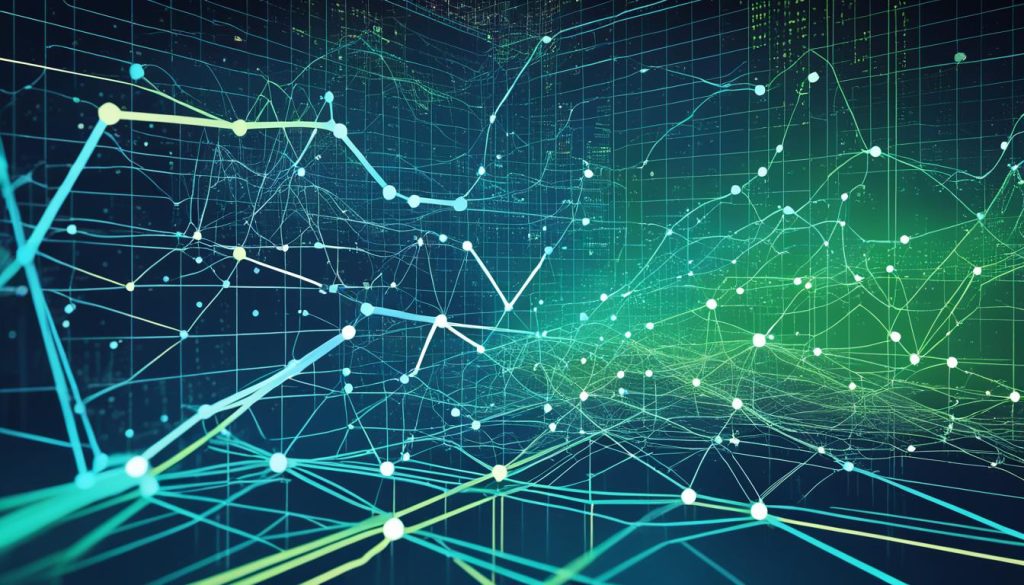Algorithmic trading has changed the finance world a lot. It uses computer algorithms to make trades automatically. This has changed how investors deal with the markets1. It has many benefits like being fast, cheap, and making decisions without emotions. But, it also has risks that investors should know about.
Technology has made algorithmic trading tools more advanced and easy to use. Now, there are many strategies and models for trading, making it more complex1. It’s important to understand market dynamics, how to manage risks, and the details of these systems.
This article will look into algorithmic trading. We’ll talk about its good points, bad points, and what’s new in this field. It’s important for both new and experienced investors to know about algorithmic trading. This knowledge helps in making smart choices and protecting your money.
Key Takeaways
- Algorithmic trading uses algorithms to make trades automatically. It offers speed, lower costs, and decisions without emotions.
- Understanding algorithmic trading systems is complex. It requires knowledge of markets, managing risks, and the technical side of these systems.
- Risks of algorithmic trading include systemic risks, challenges in execution, and how it affects the market.
- New tech like machine learning and artificial intelligence is changing algorithmic trading.
- Managing risks well is key in algorithmic trading. This includes monitoring, testing, and regularly checking your strategy.
- https://tunekong.com/pet-friendly-garden-ideas-how-to-create-a-safe-haven-for-your-furry-friends-18/
The Rise of Algorithmic Trading in Finance
Algorithmic trading uses computers to make trades with set instructions. It’s now big in finance. This method uses tech advances to look at lots of data fast. It finds good trading chances and makes trades quickly and accurately2.
It’s growing because of better data processing, more high-performance computing, and regulatory reforms. These changes make sure markets are fair and open.
What is Algorithmic Trading?
Also called automated trading, it uses algorithms to make trades. These algorithms look at market data, find good trades, and make them based on set rules3. They can process lots of info fast, so they can catch trades humans might miss.
Technological Advancements Enabling Algorithmic Trading
Big tech advances in data processing and high-performance computing helped algorithmic trading grow. Now, with lots of market data and fast processing, these systems can spot and use trading chances that humans can’t3. Machine learning and artificial intelligence let these systems learn and change with the market.
Regulatory Reforms and the Growth of Algorithmic Trading
Regulatory changes, like those from the Securities and Exchange Board of India (SEBI), have also helped. These changes make sure markets are fair and open, helping algorithmic trading grow3. As rules change, the finance world keeps up with these new techs, making the market more dynamic.
“Algorithmic development continues to evolve to achieve the best performance possible versus the client benchmark.” – Alex Harman, head of EMEA electronic and program trading at Goldman Sachs
Benefits of Algorithmic Trading Strategies
Algorithmic trading has changed the finance game with its fast execution and lower costs. It uses data to make trading decisions, offering clear benefits4.
Speed and Efficiency in Capturing Market Opportunities
Speed is crucial in finance. Algorithmic trading systems beat humans in making and executing orders fast. This lets traders grab quick market chances4. Now, trades happen in seconds, giving traders an edge4.
Reducing Transaction Costs and Improving Execution
Algorithmic trading cuts transaction costs and lessens market impact by breaking big orders into small ones4. It makes trading more efficient and accurate, lowering costs5.
Removing Human Emotions and Biases
Algorithmic trading removes emotions that can affect human decisions5. It uses set rules and data to make decisions, avoiding irrational choices. This helps traders stick to their risk levels5.
Algorithmic trading combines speed, efficiency, and unbiased decisions, making it a key tool in finance4. Traders and investors use this tech to improve their trading5.
“Algorithmic trading provides a systematic approach to active trading compared to methods reliant on trader intuition.”4
| Algorithmic Trading Strategies | Key Features |
|---|---|
| Trend-Following Strategies | Use moving averages to spot and follow market trends. |
| Arbitrage Strategies | Make profits by exploiting price differences across markets. |
| Index Fund Rebalancing | Automatically adjust index fund holdings to keep asset ratios right. |
Algorithmic trading has changed how financial markets work, from fast trades to systematic strategies4. It uses tech and data to let traders and investors move through markets with speed, efficiency, and fairness5.
algorithmic trading Strategies in Practice
Algorithmic trading is now a big part of the financial world. It uses complex computer algorithms to make trades based on math models6. This method tries to cut down on human feelings and mistakes, leading to better trades and lower costs6. There are many different ways to use algorithmic trading, each with its own goal to make money from the market.
Trend-Following Strategies
Trend-following is a common strategy in algorithmic trading. It aims to make money by following the direction of market trends6. By spotting and using these trends, traders can make a lot of money6. On the other hand, volatility strategies focus on the ups and downs of the market, especially in the forex market6.
Market-Making and Arbitrage Strategies
Some algorithmic trading strategies focus on market-making and arbitrage. Market-making algorithms help the market by buying and selling at the same time, making money from the spread between prices6. Arbitrage strategies, however, aim to make money by finding price differences across markets or assets6.
High-Frequency Trading (HFT) Strategies
High-frequency trading (HFT) is a type of algorithmic trading that makes trades very quickly6. It uses fast algorithms and systems to take advantage of short-term market chances6. HFT includes strategies like quote stuffing and trading range strategies6. It also uses inter-market spreading and index fund rebalancing to make money6.
To get good at these algorithmic trading strategies, you need to know a lot about the market and how to use complex algorithms6. As the financial world changes, it’s important to keep up with new things in algorithmic trading. Learning about these strategies can give investors and traders useful insights.

| Strategy | Description | Key Features |
|---|---|---|
| Trend-Following | Aims to capture profits by riding the momentum of prevailing market trends | Identifies and exploits persistent price movements |
| Volatility Strategies | Capitalize on the intensity of price fluctuations, particularly in the forex market | Focus on trading based on price movement intensity |
| Market-Making | Provide liquidity to the market by simultaneously posting buy and sell orders | Profit from the bid-ask spread |
| Arbitrage | Seek to exploit pricing inefficiencies across different markets or assets | Generate profits from price discrepancies |
| High-Frequency Trading (HFT) | Leverage advanced algorithms and low-latency infrastructure to execute trades at lightning-fast speeds | Capitalize on fleeting market opportunities, often involving tactics like quote stuffing and trading range strategies |
“Algorithmic trading has become a powerful tool in the financial industry, enabling traders to execute trades with speed, efficiency, and precision that surpasses human capabilities.” – Market Microstructure Specialist
As the financial world changes, it’s key to keep up with new things in algorithmic trading7. To use these strategies well, you need to understand the market and complex algorithms6. Investors and traders who use algorithmic trading can take advantage of the financial market’s changes7.
Risk Management in Algorithmic Trading
Effective risk management is key in algorithmic trading. This field offers big gains but also big losses. Traders must deal with complex risks, technical issues, and biases8.
Monitoring and Controlling Systemic Risks
Algorithmic trading has many risks, like technical problems and data errors. Traders must watch and control these risks to keep their money safe and strategies profitable8. Using stop-loss orders, diversifying portfolios, and adjusting positions can help manage these risks8.
Backtesting and Validating Trading Algorithms
Testing and checking trading models is crucial. It helps spot and fix problems in the code. By looking at past data, traders can see how well their strategies work and make them better8. Keeping data quality high and a strong tech setup is also key for reliable trading systems8.
Managing risks in algorithmic trading is an ongoing task. It needs constant checking, improving, and understanding of tech, markets, and human behavior. A strong risk management plan helps traders deal with algorithmic trading’s challenges with confidence8.

“In the world of algorithmic trading, risk management is not just a buzzword, but the very foundation upon which successful trading strategies are built.”
To succeed in algorithmic trading, you must be ready to spot, watch, and reduce risks at every step. Being alert and proactive with risk management can help you make the most of this trading method8910.
Emerging Trends and the Future of Algorithmic Trading
The future of algorithmic trading looks bright, thanks to fast tech advances and new ideas11. It started in the early 1990s and has changed the finance world. Now, it makes trading faster, more precise, and more accurate11. High-frequency trading (HFT) came next, making trades in seconds to make the most of tiny price changes11.
Machine Learning and Artificial Intelligence in Trading
Machine learning and artificial intelligence are big news in algorithmic trading1112. These techs help algorithms look through lots of data to spot complex patterns. This helps traders make better choices and lower risks12. As AI and machine learning grow, they’ll likely change algorithmic trading a lot, giving traders an edge.
Quantum Computing and Its Potential Impact
Quantum computing could change the game for algorithmic trading11. It could make algorithms faster and better at handling big data. This could lead to super-fast, precise trading that’s always on top of the market11.
Alternative Data Sources and Their Role
New kinds of data, like satellite images and social media, are giving traders new ways to win12. Using these data, traders can see things others don’t, giving them an edge12. As more traders use these data, they’ll play a big part in the future of algorithmic trading.
| Metric | Algorithmic Trading Volume |
|---|---|
| United States | 70% of total trading volume13 |
| Emerging Economies (e.g., India) | Approximately 40% of total trading volume13 |
Algorithmic trading is set to grow a lot, with a 10.3% growth rate from 2016 to 202013. As tech keeps advancing, algorithmic trading will play an even bigger role. It will likely use more machine learning, AI, quantum computing, and new data sources to shape the market.
“The future of algorithmic trading will see high levels of automation in the financial market, with algorithms becoming more complex and able to adjust to different patterns using AI.”13
Conclusion
Algorithmic trading has changed the way we invest, using tech, data, and smart choices to improve our strategies14. It lets us make the most of today’s fast markets by understanding its pros, cons, and new trends15.
The financial world is always changing, and algorithmic trading will play a big part in the future of investing16. It makes trading fast and helps remove emotional decisions, making markets better and cheaper15. But, it also has risks like system failures and market ups and downs15.
To keep up, staying informed and flexible is key16. Using tools for algorithmic trading helps you get to know the market better, test your strategies, and grow your trading skills as you gain confidence16. With new tech like machine learning and artificial intelligence, the future of algorithmic trading looks bright for those ready to use data to make choices16.
FAQ
What is algorithmic trading?
Algorithmic trading uses computers to make trades automatically. It looks at things like time, price, and volume. This method is fast, saves money, and doesn’t let emotions decide.
How has algorithmic trading grown in India?
In India, algorithmic trading has grown thanks to tech like fast computers and cloud services. Also, rules from the Securities and Exchange Board of India (SEBI) help keep things fair and clear.
What are the key benefits of algorithmic trading?
It’s fast and efficient, cutting down on costs and making trades better. It also removes human feelings and biases from trading decisions.
What are the common algorithmic trading strategies used in the Indian market?
In India, traders use strategies like following trends, making markets, and arbitrage. High-frequency trading also uses fast algorithms and infrastructure to make quick trades.
How is risk management crucial in algorithmic trading?
Managing risk is key to keep trading safe and successful over time. It means watching out for risks, testing trading plans, and making sure they work well.
What are the emerging trends in algorithmic trading?
The future of algorithmic trading looks exciting with new tech like machine learning and artificial intelligence. Quantum computing and more data sources are also changing the game.

